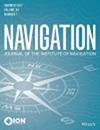Autonomous Lunar L1 Halo Orbit Navigation Using Optical Measurements to a Lunar Landmark
IF 2
3区 地球科学
Q1 ENGINEERING, AEROSPACE
引用次数: 0
Abstract
Autonomous cislunar spacecraft navigation is critical to mission success as communication to ground stations and access to global positioning system (GPS) signals could be lost. However, if the satellite has a camera of sufficient quality, geometric line-of-sight (unit vector) measurements can be made to known lunar landmarks (e.g., Tycho Crater) to provide observations that enable autonomous estimation of the position and velocity of the spacecraft. In this study, an improved batch gaussian initial orbit determination (IOD) differential correc-tor (DC) algorithm, based on the approximated values of the two-body f and g series, is applied to initialize a (non-conic based) circular restricted three body problem (CR3BP) extended Kalman Filter (EKF) navigator. This navigator collects geometric line-of-sight unit vector (angle only) measurements to a known location on the Moon to sequentially estimate the position and velocity of an observer spacecraft flying on an approximate southern L1 Halo orbit. In this study, it基于月球地标光学测量的月球L1晕轨道自主导航
自主地月航天器导航对任务成功至关重要,因为与地面站的通信和对全球定位系统(GPS)信号的访问可能会丢失。但是,如果卫星有足够质量的相机,则可以对已知的月球地标(例如第谷陨石坑)进行几何视距(单位矢量)测量,以提供观测结果,从而能够自主估计航天器的位置和速度。本文提出了一种改进的批量高斯初始定轨(IOD)差分校正(DC)算法,该算法基于两体f和g级数的近似值,用于初始化(非圆锥型)圆形受限三体问题(CR3BP)扩展卡尔曼滤波(EKF)导航器。这个导航仪收集几何视线单位矢量(仅角度)测量到月球上的一个已知位置,依次估计在大约L1光环南部轨道上飞行的观测航天器的位置和速度。在这项研究中,它
本文章由计算机程序翻译,如有差异,请以英文原文为准。
求助全文
约1分钟内获得全文
求助全文
来源期刊

Navigation-Journal of the Institute of Navigation
ENGINEERING, AEROSPACE-REMOTE SENSING
CiteScore
5.60
自引率
13.60%
发文量
31
期刊介绍:
NAVIGATION is a quarterly journal published by The Institute of Navigation. The journal publishes original, peer-reviewed articles on all areas related to the science, engineering and art of Positioning, Navigation and Timing (PNT) covering land (including indoor use), sea, air and space applications. PNT technologies of interest encompass navigation satellite systems (both global and regional), inertial navigation, electro-optical systems including LiDAR and imaging sensors, and radio-frequency ranging and timing systems, including those using signals of opportunity from communication systems and other non-traditional PNT sources. Articles about PNT algorithms and methods, such as for error characterization and mitigation, integrity analysis, PNT signal processing and multi-sensor integration, are welcome. The journal also accepts articles on non-traditional applications of PNT systems, including remote sensing of the Earth’s surface or atmosphere, as well as selected historical and survey articles.
 求助内容:
求助内容: 应助结果提醒方式:
应助结果提醒方式:


